Pushing and punching. Spreading rumors and name-calling. Whether it’s physical or verbal, bullying has no place at school or in cyberspace.
Parents can help children not be bullied or be bulliers, but first it is important to understand why bullying occurs, said Tammy Wilgenbusch, Ph.D., a clinical psychologist with University of Iowa Children’s Hospital.
“Bullying can start at any age but it increases and then peaks in early adolescence, between sixth and ninth grades,” Wilgenbusch said. “At that time, children are developing their personalities and independence so they may be more likely to take their insecurities out on or try to wield power over others. By later adolescence, they have a better sense of self and are less likely to take insecurities out on others.”
Bullying is a negative or aggressive act that is systematic and ongoing. It can be instigated by one person or a group of individuals. “Typically, the person doing the bullying is seen as more powerful, whether it is physical or social status or better language skills,” Wilgenbusch said.
Children who are bullied are at higher risk of mental health problems, particularly depression and anxiety. Some studies show that children who display more anger are more likely to bully because they do not have proper anger-management skills, Wilgenbusch explained.
Children who are bullied can develop personality or temperament changes, such as withdrawal, sleep or appetite changes, and decreased academic performance.
“Some children can cope effectively with bullying, but if it interferes with daily living then it’s a good idea to provide strategies for dealing with the bullying and building self-esteem. You can get a referral for counseling from a school counselor or psychologist or primary care physician,” Wilgenbusch said.
Teasing is a form of bullying, and research shows that children rate it as the most common form of bullying they encounter.
“When bulliers get a reaction, they are more likely to continue to bully. Encourage your child to ignore the teasing or come back with a quick-witted, non-threatening response. ‘Agreeing’ with the bullier’s comment and making a joke can take the power out of the comment,” Wilgenbusch said.
When it comes to physical bullying, however, it is best to report attacks. “If the aggression is physical, the bullier needs to face consequences,” Wilgenbusch said.
Parents can meet with teachers and school personnel. “Get everyone involved and set up a ‘no-tolerance’ system that allows students to feel safe to report incidences,” she said.
Wilgenbusch emphasized that bullying prevention may require school-wide changes in the environment. “The change needs to take place at all levels — from the principal to the students — to create an environment where bullying is not appropriate and instead focus on positive interactions,” she said.
Wilgenbusch noted that “relational bullying” — which is bullying to hurt someone’s status within a social group — is much more common because of the Web and access to blogs and social networking groups.
“It is key for parents to monitor and observe what their children are posting and looking at online. Supervision is more difficult when it comes to Web activities but you need to talk to your children and help them problem solve,” she sad.
Wilgenbusch and colleagues recommend limiting computer access in bedrooms or isolated areas. Having a computer in the open allows more interaction and opportunities for parents to monitor behavior.
If parents learn their child is bullying, they should talk to them and let them know it is not appropriate, Wilgenbusch said. “You can’t just tell them to stop. You need to really talk with them to help them learn to empathize with the other person and to think about why they’re bullying and what they are getting out of it.”
To learn more about how to prevent bullying, visit http://stopbullyingnow.hrsa.gov or http://www.safeyouth.org.
Source: University of Iowa Health Sciences

